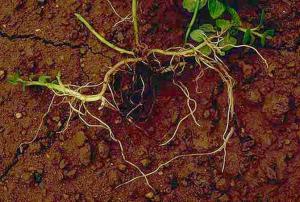|
Nematode Parasites Found In Mint |
|||
CONTENTS
|
Horner and Jensen (1954) were the first to examine plant-parasitic nematodes from mint plantings in Oregon. They recovered northern root-knot nematodes from spearmint and determined that this nematode would parasitize peppermint as well. Pin nematodes were present in most fields examined and earlier had been associated with fungi causing rhizome and root rot (Horner, 1952). Mint nematodes were associated with many areas of stunted and dying peppermint that exhibited a root die-back condition. Underground mint shoots were found infected with foliar nematodes, with as many as 400 nematodes in a single root tip. However, these nematodes could not be recovered from shoot tips after shoots had emerged from the ground. In a 1986 survey evaluating 238 samples from mint fields in Oregon, Ingham (unpubl.) found lesion, pin, stubby-root, mint, ring and root-knot nematodes in 91%, 86%, 9%, 2%, 2% and 1% of the samples, respectively. Lesion and pin nematodes were also the most abundant with 30% and 43% of the samples having more than 2000/quart soil of lesion or pin nematodes. |

